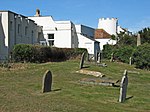Nornen
1876 ships1897 in England19th century in SomersetBarquesDisasters in Somerset ... and 3 more
Maritime incidents in 1897Ships built in FranceShipwrecks in the Bristol Channel

The Nornen was a large sailing vessel of the barque type. The three masts were typical of barque ships; the foremast and mainmast square-rigged and the mizzenmast (stern) rigged fore-and-aft. The main mast could be rigged with up to five horizontal yards. The ship was built and launched in 1876 at Chantiers de la Roque of Bordeaux, France. She was named the Maipu, and ran under the French shipping line A.D Bordes & Fils. The cargo hold could carry ample goods across the Atlantic. Peder Olsen was the captain for her final three years, frequently running trade routes between American east coast ports and Europe.
Excerpt from the Wikipedia article Nornen (License: CC BY-SA 3.0, Authors, Images).Nornen
Coast Road,
Geographical coordinates (GPS) Address External links Nearby Places Show on map
Geographical coordinates (GPS)
| Latitude | Longitude |
|---|---|
| N 51.27167 ° | E -3.02348 ° |
Address
SS Nornen
Coast Road
TA8 2QS
England, United Kingdom
Open on Google Maps










